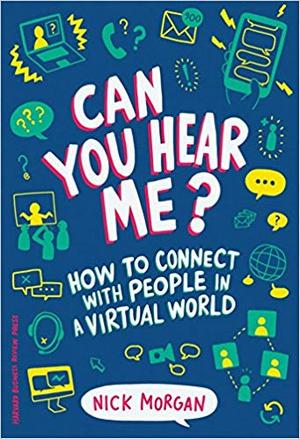It had been just over two months … two freakin’ months … since I’d talked to my boss. I knew this because I pulled out my phone, opened his contact page, and looked at the history. The only call longer than 20 seconds occurred 63 days prior.
Yes, our email conversations during that time tallied quite a number (to be exact, 147 conversations with a combined 324 emails.) And I sent about 25 text messages (19 received a response.)
But I had not seen Robert (not my former boss’ real name) or even heard his voice in 63 days. Yet Robert was still providing guidance to the team. Leadership, though, was questionable.
The Rise of the Digital Leader
The number of digital leaders continues to grow in the engineering world. With more work performed solely on computers and with better online communications, managers attempt to lead electronically more frequently than ever before.
Of course, we (engineers) created the problem ourselves over the last couple of decades.
- Technology allows our engineering workforce to spread out around the country, reducing the need and ability for face-to-face meetings and increasing the need for email.
- We’re mostly introverts so it’s easier to send an email than it is to go to our boss’ office and ask a question.
- Our bosses, possibly engineers and possibly introverts as well, might find it easier to respond with an email than a face-to-face conversation.
- Our senior leaders have more direct reports and are managing them more through email to maintain connections.
- Our customers are busy and, “How about that … I can just send an email and they’ll answer me right away!”
Pretty soon, the problem self-propagates.
In August, I was at a professional development conference for a week and didn’t have access to my work email. I came back to work to find just over 400 emails in my inbox after five days away. Several of my coworkers told me, “I didn’t CC you on this because you were out of the office.” So what’s my normal total? About 500 per week. That’s 100 per day or 12 an hour or one every five minutes.
And I bet some of you have it a lot worse than that.
We don’t have time for an in-person meeting because we’ll be hammered with email when we get back to our desk. Instead of a meeting, let’s just exchange a few more emails.
Oops.
And, of course, we (maybe not you and me, but some engineer somewhere) created wonderful online task and project management tools (JIRA, Basecamp, Asana, etc) which enable us to have even fewer in-person conversations.
Again, oops.
The Fall of the Disconnected Team
At first, a lot of us said, “Whew! Fewer meetings.”
Is it just me or does anyone else get sick of meetings? Maybe it’s just me. Nope, it’s not. 114,000,000 hits on google for I’m sick of meetings.
But we paid a price for our digital transformation. Harvard Business Review’s Managers Are More Connected, But Not For The Better and Medium’s The Growing Need for Connection in the Digital Age both reference the loss of conversation.
Taking it a step further, in his book Can You Hear Me?, Nick Morgan explains that humans evolved to communicate face to face and to distrust communication that is not in person. It’s only been the last 100 years, starting with the advent of the telephone, that quick, non-face-to-face communication has been possible. And there have been plenty of misunderstood communications during that time.
When was the last time someone got upset or irritated over an email you wrote and you had to explain, “That’s not what I meant!”? Or when was the last time you got twisted up over an email?
Morgan says we misunderstand these communications because our lizard brain kicks in and produces new information which is meant to protect us.
“When the multichannel sensory system that is the brain is deprived of one or more of those senses [physical cues, tone, etc,] the neuroscientists tell us it hates the vacuum. So, the brain fills in the empty channels with assumptions, memories, and fake data. The result is, not surprisingly, all the misunderstandings we’re so familiar within the virtual world,” writes Morgan. For example, “The email that conveys a sarcastic tone the sender didn’t intend.”
When using digital means, we lack the emotional exchange that our human brains need in order to feel connected and safe.
Staying Connected in an Increasingly Digital World
Even though it reduces the need and ability for face-to-face meetings, I love that technology allows our engineering workforce to spread out around the country. I’m glad that my teammate TJ got to move back to Maine (a 34-hour drive from where we worked together) to be near family while keeping his job. I thought it was extremely cool that Matt, another teammate, took an entire summer to travel across the northern United States without missing a single day of work.

And my wife loved it when I worked from home for 14 months and folded all the laundry during conference calls. Yes, for 14 months she didn’t even look at the washer and dryer.
Past generations could not fathom these luxuries. Neither could Lisa.
Even though they come at a cost, we can stay connected (and pacify our human brains) through a little effort. Of course, this requires some of that time we saved by sending an email rather than calling someone on the phone or having a meeting.
Get your team face-to-face and let them socialize, not just work.
Getting your team together to work is great. But when you cram in long days just because everyone is together, there’s a lack of bonding. Be sure to schedule in time for social activities.
Get your team face-to-face using video conferencing.
One of the best tools we had for our distributed team was GotoMeeting (although more recently we’ve switched to Zoom.) These let your team (and sometimes stakeholders outside your team) join meetings, see each other, and share computer screens. These tools provide a far richer experience than just using a speakerphone. We now insist on video for all team meetings. What happens if you got up late and didn’t get a shower? Put on a hat and turn on your camera.
Call your coworkers, don’t just email them.
Take the time to make a phone call to each team member regularly. You can still hammer them with email, but skip the keyboard once in a while and reach out on the phone.
Meet your coworkers face-to-face, don’t just call them.
If you’re in the same office, skip another email and go talk to someone face-to-face. If not, use Skype, Teams, or some other video chat system to have that conversation.
Be personal with your team.
Work is more than just work. It’s roughly one-third of your life. Spend part of your time getting to know your co-workers and letting them get to know you. Don’t make work only about work.
The Final Takeaway
The needs of our jobs and the emerging technologies conspire to make the lack of human contact even more of a problem in the future. The need for ever more digital leaders grows at the speed of business.
For your sake and that of your team, don’t be one of them.

Author: Tracy Thomason
Agile project manager by day, craft beer drinker by night, and avid reader anytime I can get 5 minutes alone with my Kindle.
More posts by Tracy
Featured image by Robinraj Premchand from Pixabay



It’s tough to share drinking a craft beer 🍻 via email. Hmmm, perhaps we need to have more face to face gatherings if only to support the craft beer industry.
Great article. Prost!
I would love that, John! I’m all for supporting the craft beer industry! And hanging out with you would be a bonus!